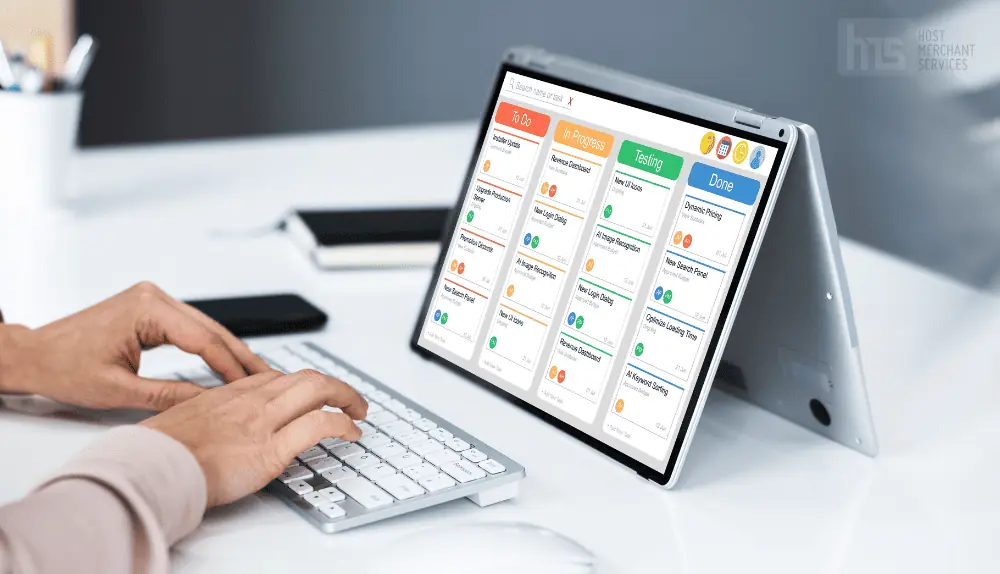In the ever-evolving landscape of technology, it seems that the boundaries between business software and social media platforms are beginning to blur. As we dive into the year 2023, a fascinating trend is emerging: the convergence of user interface (UI) designs between these two seemingly disparate worlds. Gone are the days of clunky interfaces and uninspiring user experiences in the business software realm. Instead, we find ourselves in a time where our tools for productivity and collaboration bear an uncanny resemblance to the engaging and visually captivating interfaces of social media.
Join us on this exploration of the intriguing UI trends shaping the business software landscape and discover why is my business software starting to look like social media. Why a once-dull applications are now starting to resemble the very platforms that have captured our attention and transformed the way we connect, share, and communicate.
What is UI/UX?
UI (User Interface) and UX (User Experience) are two crucial components of software design that focus on enhancing the interaction between users and digital systems. UI refers to the visual and interactive elements of a software application or website that users engage with directly. It encompasses the layout, buttons, icons, menus, and other visual elements that make up the interface. The goal of a well-designed UI is to provide users with a visually appealing and intuitive interface that allows them to easily navigate, understand, and interact with the software.
On the other hand, UX is concerned with the overall experience a user has while using a product or system. It goes beyond just the interface and encompasses the entire user journey, from their initial interaction with the software to their overall satisfaction and impression. UX design focuses on understanding user needs, conducting research, creating wireframes and prototypes, and optimizing the product to ensure a seamless and meaningful user experience.
In essence, UI and UX work hand in hand to create a user-friendly and engaging digital environment. While UI deals with the aesthetics and functionality of the interface, UX takes a holistic approach to design, ensuring that the software meets user expectations, goals, and provides a satisfying experience.
Why is My Business Software Starting to Look Like Social Media? How Business Software UI/UX Has Changed?

The landscape of business software user interface (UI) and user experience (UX) has witnessed a significant transformation in recent years. As technology advances and user expectations evolve, businesses are recognizing the importance of creating intuitive, visually appealing, and engaging software interfaces. In this section, we will explore the key changes that have shaped the UI/UX of business software, highlighting the shift towards user-centric design and the integration of elements inspired by social media platforms.
From Functionality to User-Centric Designs
Traditionally, business software placed emphasis on functionality, often neglecting the importance of user experience. However, as the digital world became more user-oriented, the focus shifted towards user-centric design. Businesses realized that creating software with an intuitive and user-friendly interface improves productivity, reduces learning curves, and enhances overall satisfaction. As a result, UI/UX teams began incorporating principles of user-centered design, conducting user research, and incorporating user feedback to shape the software interface.
Streamlined and Minimalistic Interfaces
One noticeable change in business software UI is the move towards streamlined and minimalistic interfaces. Cluttered screens overloaded with complex menus and buttons have given way to clean, visually appealing layouts. This minimalist approach not only enhances the aesthetics but also improves usability by reducing cognitive load, making it easier for users to navigate and find the information or features they need.
Enhanced Visual Appeal and Branding
In an increasingly competitive market, businesses recognize the importance of brand consistency and differentiation. As a result, business software UI/UX has evolved to incorporate visually appealing elements that align with the organization’s branding. Companies now strive to create software interfaces that reflect their brand identity through color schemes, typography, and graphical elements. This approach not only reinforces brand recognition but also contributes to a cohesive user experience across various touchpoints.
Integration of Social Media-inspired Elements
The rise of social media platforms has had a significant influence on UI/UX design across various domains, including business software. Users have become accustomed to the intuitive and engaging interfaces of social media platforms, and businesses have started to incorporate similar elements in their software to enhance user engagement. Features such as activity feeds, real-time notifications, and interactive elements are now being integrated into business software interfaces, providing users with a familiar and engaging experience.
Mobile Responsiveness and Cross-Platform Compatibility
With the proliferation of smartphones and tablets, mobile responsiveness has become a crucial aspect of UI/UX design. Business software is no exception, as users increasingly expect to access applications on their mobile devices. UI/UX designers now prioritize responsive design principles to ensure software interfaces adapt seamlessly to different screen sizes and orientations. Moreover, cross-platform compatibility has gained prominence, enabling users to seamlessly switch between devices while maintaining a consistent experience.
Emphasis on Accessibility and Inclusivity
Another significant change in business software UI/UX is the growing emphasis on accessibility and inclusivity. Designing software that is accessible to users with disabilities has become a priority, driven by the need for equal opportunities and compliance with accessibility standards. UI/UX teams are incorporating features such as alternative text for images, keyboard navigation support, and color contrast enhancements to ensure that software interfaces are usable by individuals with diverse abilities.
The evolution of business software UI/UX has seen a paradigm shift, placing greater emphasis on user-centric design, streamlined interfaces, visual appeal, and integration of social media-inspired elements. The transformation reflects the growing recognition of the impact of UI/UX on user satisfaction, productivity, and overall business success. As technology continues to advance, businesses must adapt to evolving user expectations, leveraging the power of UI/UX design to create software interfaces that not only meet functional requirements but also provide a delightful and engaging experience for users.
Factors Driving the Business Software UI/UX Changes

The user interface (UI) and user experience (UX) of business software have undergone significant changes in recent years. Several factors have contributed to this evolution, driven by technological advancements, changing user expectations, and the need for increased productivity and efficiency. In this section, we will explore the key factors driving the changes in business software UI/UX and their implications for user satisfaction and business success.
Technological Advancements
The rapid advancements in technology have played a crucial role in driving changes in business software UI/UX. With the rise of cloud computing, mobile devices, and high-speed internet connectivity, users now expect seamless experiences across different platforms and devices. UI/UX designers have responded by incorporating responsive design principles, ensuring that software interfaces adapt and function seamlessly on various screen sizes and resolutions.
Shift to User-Centric Design
One of the significant driving factors behind UI/UX changes in business software is the shift towards user-centric design. Businesses have realized the importance of creating software that is intuitive, easy to navigate, and visually appealing. They understand that a positive user experience leads to increased productivity, user satisfaction, and customer loyalty. User research, usability testing, and feedback loops have become integral parts of the design process, enabling UI/UX teams to align software interfaces with user needs and preferences.
Changing User Expectations
User expectations have evolved significantly, influenced by their experiences with consumer-oriented applications and digital platforms. Users now expect business software to provide the same level of usability, intuitiveness, and visual appeal as their favorite consumer apps. They demand software interfaces that are clean, minimalist, and aesthetically pleasing. Additionally, users expect personalized experiences, real-time updates, and seamless integration with other tools and systems. To meet these expectations, UI/UX designers must stay informed about the latest trends and incorporate elements that enhance the overall user experience.
Rise of Mobile Devices
The proliferation of mobile devices has had a profound impact on business software UI/UX. With the increasing number of users accessing software applications on smartphones and tablets, mobile responsiveness has become essential.
Businesses recognize the importance of providing a consistent and seamless user experience across devices, and UI/UX designers are tasked with creating interfaces that adapt to different screen sizes, touch interactions, and mobile-specific constraints. Mobile-first or mobile-friendly approaches are now common, ensuring that users can access and interact with business software efficiently on the go.
Integration of Data Visualization
As businesses generate vast amounts of data, there is a growing need for effective data visualization in business software UI/UX. Users want to be able to interpret and make sense of complex data quickly and intuitively. UI/UX designers are incorporating interactive charts, graphs, and dashboards that enable users to visualize data, derive insights, and make informed decisions. Data-driven UI/UX design not only enhances the user experience but also improves productivity and data-driven decision-making within organizations.
Emphasis on Collaboration and Communication
Modern businesses recognize the importance of collaboration and communication within their software tools. UI/UX changes in business software reflect this emphasis, with the integration of features that enable seamless collaboration, real-time communication, and file sharing. Software interfaces now incorporate chat functionalities, task management tools, project collaboration spaces, and shared workspaces. These features facilitate teamwork, improve efficiency, and contribute to a more engaging user experience.
Several factors are driving the changes in business software UI/UX, including technological advancements, the shift to user-centric design, changing user expectations, the rise of mobile devices, the integration of data visualization, and the emphasis on collaboration and communication.
Businesses that prioritize UI/UX design and adapt to these driving factors are better positioned to provide software interfaces that meet user needs, enhance productivity, and drive overall business success. As technology continues to evolve and user expectations evolve, staying attuned to these factors and continuously improving UI/UX design will remain crucial for businesses in delivering exceptional user experiences.
Impact of Increased Employee Demands on Business Software UI/UX

Employees today have higher expectations when it comes to the user interface (UI) and user experience (UX) of business software. As technology advances and consumer applications set new standards for usability and visual appeal, employees now demand intuitive, efficient, and visually engaging software interfaces in their professional environments. In this article, we will explore how increased demands from employees have influenced and changed business software UI/UX.
Consumerization of IT
The consumerization of IT refers to the trend of employees expecting their work software to match the user-friendly and visually appealing interfaces of the applications they use in their personal lives. With the widespread adoption of smartphones and popular consumer applications, employees have become accustomed to seamless experiences, sleek designs, and intuitive interactions. As a result, they expect similar qualities in their business software, leading to a paradigm shift in UI/UX design.
Simplified Workflows and Efficiency
Employees now seek business software that simplifies their workflows, automates repetitive tasks, and streamlines complex processes. They want software interfaces that are easy to navigate, with intuitive menu structures and clear visual cues. UI/UX designers are responding to these demands by focusing on creating software interfaces that reduce cognitive load, minimize clicks, and enable employees to complete tasks efficiently.
A well-designed UI/UX contributes to increased productivity, saves time, and enhances overall employee satisfaction.
Mobile Workforce and Remote Collaboration
The rise of remote work and the increasing number of mobile employees have significantly impacted business software UI/UX. Employees expect software interfaces that are mobile-responsive and enable seamless access and collaboration across different devices and locations.
They require interfaces that adapt to varying screen sizes, touch interactions, and limited bandwidth while maintaining functionality and usability. UI/UX designers are incorporating responsive design principles and optimizing software interfaces for mobile devices to cater to the demands of a mobile workforce.
Personalization and Customization
Employees desire software interfaces that can be personalized and customized to align with their individual work preferences and needs. They seek the ability to personalize dashboards, layouts, and settings to enhance their productivity and make the software feel tailored to their specific roles and tasks. UI/UX designers are incorporating customization options, flexible layouts, and configurable features that empower employees to personalize their software experience. This personal touch improves employee engagement and fosters a sense of ownership over the software.
Integration and Seamless Workflows
Employees often work with multiple software applications and tools to perform their tasks. They expect seamless integrations between different software systems, enabling smooth data transfer, real-time updates, and consistent experiences.
UI/UX designers are focusing on creating cohesive software interfaces that integrate seamlessly with other applications, providing employees with a unified and streamlined experience. By minimizing the need for context-switching and reducing manual data entry, businesses can enhance employee productivity and satisfaction.
Training and Onboarding
Employees increasingly value software interfaces that are easy to learn and require minimal training or onboarding. They expect software that follows familiar design patterns and uses intuitive interactions. UI/UX designers are incorporating design principles such as consistency, affordance, and user guidance to create interfaces that are intuitive and self-explanatory. By reducing the learning curve and facilitating quick adoption, businesses can improve employee onboarding processes, save time, and reduce training costs.
Benefits of Using Business Software with Good UI/UX
Using business software with a good user interface (UI) and user experience (UX) can provide numerous benefits for organizations. Here are some key advantages:
Increased Productivity
A well-designed UI/UX reduces the learning curve and makes it easier for employees to navigate and use the software. Intuitive interfaces and streamlined workflows enable users to accomplish tasks more efficiently, leading to increased productivity and time savings.
Enhanced User Satisfaction
Good UI/UX design focuses on creating a positive user experience, resulting in higher user satisfaction. Employees who find the software easy to use, visually appealing, and engaging are more likely to enjoy their work and feel more satisfied with their overall experience.
Reduced Training and Support Costs
Intuitive UI/UX design minimizes the need for extensive training and support. Employees can quickly grasp the software’s functionalities, reducing the time and resources required for onboarding and ongoing assistance. This leads to cost savings for the organization.
Error Reduction and Increased Accuracy
Well-designed UI/UX can help minimize errors and improve data accuracy. Clear visual cues, logical workflows, and error prevention mechanisms reduce the likelihood of mistakes during data entry or complex processes. This results in improved data quality and reduces the risk of costly errors.
Competitive Advantage
Business software with excellent UI/UX can give organizations a competitive edge. A visually appealing and user-friendly interface enhances the perception of professionalism and modernity. It can attract and retain customers, differentiate the organization from competitors, and contribute to a positive brand image.
Increased Adoption and Engagement
Employees are more likely to adopt and fully utilize software that offers a good UI/UX. A well-designed interface encourages user engagement and active participation, leading to higher adoption rates and maximizing the return on investment for the software.
Scalability and Flexibility
Good UI/UX design takes into account scalability and adaptability. As businesses grow and evolve, the software interface can be easily scaled or modified to accommodate changing needs and additional functionalities. This flexibility ensures that the software remains relevant and usable over time.
Accessibility and Inclusivity
UI/UX design that considers accessibility requirements ensures that the software is usable by individuals with disabilities. Features such as keyboard navigation support, screen reader compatibility, and color contrast enhancements improve accessibility, promoting inclusivity within the organization.
Data-driven Decision Making
Well-designed data visualization features in business software UI/UX enable users to analyze and interpret data effectively. Interactive charts, graphs, and dashboards present information in a visually engaging manner, facilitating data-driven decision-making and empowering employees to derive insights from complex data sets.
Final Words
In conclusion, the benefits of using business software with good UI/UX are manifold. Organizations that prioritize user-centric design and invest in creating intuitive, visually appealing, and engaging software interfaces reap the rewards of increased productivity, enhanced user satisfaction, and reduced training and support costs. Furthermore, such software fosters collaboration reduces errors, and boosts accuracy, providing a competitive advantage in today’s fast-paced business landscape.
The adoption of business software with excellent UI/UX drives user engagement maximizes the software’s potential, and contributes to a positive brand image. Additionally, the scalability, accessibility, and data-driven decision-making capabilities offered by well-designed UI/UX empower organizations to adapt and make informed choices.
Ultimately, by recognizing the importance of UI/UX and incorporating it into their software solutions, businesses can unlock the full potential of their technology investments and drive success in the digital age.
Frequently Asked Questions (FAQs)
Why is UI/UX important in business software?
UI/UX is important in business software as it directly impacts user satisfaction, productivity, and overall user experience. A well-designed interface makes the software intuitive, easy to use, and visually appealing, leading to increased adoption and improved efficiency within an organization.
How does good UI/UX design contribute to increased productivity?
Good UI/UX design reduces the learning curve, streamlines workflows, and provides clear navigation, resulting in faster task completion and increased productivity. Well-designed interfaces minimize cognitive load and enable users to focus on their work rather than struggling with complex or confusing software interactions.
What role does mobile responsiveness play in business software UI/UX?
Mobile responsiveness is crucial in business software UI/UX due to the increasing use of mobile devices and remote work. Mobile-responsive interfaces ensure that software is accessible and usable across different screen sizes and devices, enabling employees to work efficiently and effectively while on the go.
How can UI/UX design contribute to employee satisfaction?
UI/UX design influences employee satisfaction by creating software interfaces that are visually appealing, easy to navigate, and intuitive to use. A positive user experience enhances employee engagement, reduces frustration, and fosters a sense of ownership and pride in their work tools.
What are some key considerations for designing accessible UI/UX in business software?
Designing accessible UI/UX in business software involves considering factors such as keyboard navigation support, color contrast for visual impairments, text alternatives for images, and compatibility with screen readers. Accessibility ensures that individuals with disabilities can use the software effectively, promoting inclusivity within the organization.

